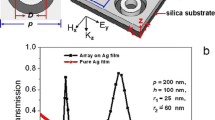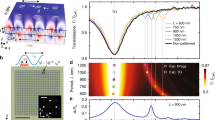Abstract.
We calculate the effective dielectric tensor of a metal film penetrated by cylindrical holes filled with a nematic liquid crystal (NLC). We assume that the director of the NLC is parallel to the film, and that its direction within the plane can be controlled by a static magnetic field, via the Freedericksz effect. To calculate the effective dielectric tensor, we consider both randomly distributed holes (using a Maxwell-Garnett approximation) and a square lattice of holes (using a Fourier technique). Both the holes and the lattice constant of the square lattice are assumed small compared to the wavelength. The films are found to exhibit extraordinary light transmission at special frequencies related to the surface plasmon resonances of the composite film. Furthermore, the frequencies of peak transmission are found to be substantially split when the dielectric in the holes is anisotropic. For typical NLC parameters, the splitting is of order 5–10% of the metal plasma frequency. Thus, the extraordinary transmission can be controlled by a static magnetic or electric field whose direction can be rotated to orient the director of the NLC. Finally, as a practical means of producing the NLC-filled holes, we consider the case where the entire perforated metal film is dipped into a pool of NLC, so that all the holes are filled with the NLC, and there are also homogeneous slabs of NLC on both sides of the film. The transmission in this geometry is shown to have similar characteristics to that in which the NLC-filled screen is placed in air.
Similar content being viewed by others
References
T.W. Ebbesen, H.H.J. Lezec, H.F. Ghaemi, T. Thio, P.A. Wolff, Nature 391, 667 (1998)
H.F. Ghaemi, T. Thio, D.E. Grupp, T.W. Ebbesen, H.J. Lezec, Phys. Rev. B 58, 6779 (1998)
J.A. Porto, F.J. Garcia-Vidal, J.B. Pendry, Phys. Rev. Lett. 83, 2845 (1999)
L. Martin-Moreno, F.J. Garcia-Vidal, H.J. Lezec, K.M. Pellerin, T. Thio, J.B. Pendry, T.W. Ebbesen, Phys. Rev. Lett. 86, 1114 (2001)
Y.M. Strelniker, D.J. Bergman, Phys. Rev. B 59, R12763 (1999)
Y.M. Strelniker, D.J. Bergman, Phys. Rev. B 50, 14001 (1994)
D.J. Bergman, Y.M. Strelniker, Phys. Rev. B 49, 16256 (1994)
D.J. Bergman, Y.M. Strelniker, Phys. Rev. Lett. 80, 857 (1998)
D.M. Newman, M.L. Wears, R.J. Matelon, Europhys. Lett. 68, 692 (2004)
G. Duchs, G.L.J.A. Rikken, T. Grenet, P. Wyder, Phys. Rev. Lett. 87, 127202 (2001)
L.E. Helseth, Phys. Rev. B 72, 033409 (2005)
A. Garcia-Martin, G. Armelles, S. Pereira, Phys. Rev. B 71, 205116 (2005)
M. Diwekar, V. Kamaev, J. Shi, Z.V. Vardeny, Appl. Phys. Lett. 84, 3112 (2004)
M. Golosovsky, Y. Neve-Oz, D. Davidov, Phys. Rev. B 71, 195105 (2005)
B. Sepulveda, L.M. Lechuga, G. Armelles, J. Lightwave Technology 24, 945 (2006)
A. Boardman, N. King, Y. Rapport, L. Velasco, New Journal of Physics 7, 191 (2005)
K. Busch, S. John, Phys. Rev. Lett. 83, 967 (1999)
J. Müller, C. Sönnichsen, H. von Poschinger, G. von Plessen, T.A. Klar, J. Feldmann, Appl. Phys. Lett. 81, 171 (2002)
S.Y. Park, D. Stroud, Appl. Phys. Lett. 85, 2920 (2004)
S.Y. Park, D. Stroud, Phys. Rev. Lett. 94, 217401 (2005)
D. Kang, J.E. Maclennan, N.A. Clark, A.A. Zakhidov, R.H. Baughman, Phys. Rev. Lett. 86, 4052 (2001)
H. Takeda, K. Yoshino, Phys. Rev. B 66, 115207 (2002)
In reality, the orientation of the director within the cylindrical hole is controlled by a balance between surface forces, the various elastic constants of the NLC, and any applied static electric or magnetic fields. However, in carrying out of our calculations, we neglect the influence of the cylindrical hole walls on the liquid crystal. In a realistic hole, the walls might locally reorient \(\hat{n}\), causing it to be locally perpendicular to the wall. This effect has not been included in our calculations. As discussed by Lubensky et al. [T.C. Lubensky, D. Pettey, N. Currier, H. Stark, Phys. Rev. E 57, 610 (1998)], this effect is typically small, for composites with length scales less than around 0.3 μm. For composites with larger length scales, such reorientation might need to be considered
P.G. de Gennes, J. Prost, The Physics of Liquid Crystals (Clarendon Press, Oxford, 1991)
V. Freedericksz, V. Zolina, Z. Krist. B 72, 255 (1931); Trans. Faraday Soc. 29, 919 (1933)
Y.M. Strelniker, D.J. Bergman, Eur. Phys. J. AP 7, 19 (1999)
D. Stroud, Phys. Rev. B 12, 3368 (1975)
D.J. Bergman, Y.M. Strelniker, Phys. Rev. B 60, 13016 (1999)
L.D. Landau, E.M. Lifshitz, L.P. Pitaevskii, Electrodynamics of Continuous Media, 2nd edn. (Pergamon, Oxford, 1993)
D.J. Bergman, D. Stroud, Solid State Physics 46, 147 (1992)
L.M. Blinov, V.A. Kizel, V.G. Rumyantsev, V.V. Titov, J. Phys. 36, Colloq. C1, C1-69 (1975)
L.M. Blinov, V.G. Chigrinov, Electro-Optic Effects in Liquid Crystal Materials (Springer-Verlag, New York, 1994)
C. Sönnichsen, A.C. Duch, G. Steininger, M. Koch, G. von Plessen, Appl. Phys. Lett. 76, 140 (2000)
A.M. Dykhne, A.K. Sarychev, V.M. Shalaev, Phys. Rev. B 67, 195402 (2003)
D.S. Kim, S.C. Hohng, V. Malyarchuk, Y.C. Yoon, Y.H. Ahn, K.J. Yee, J.W. Park, J. Kimm, Q.H. Park, C. Lienau, Phys. Rev. Lett. 91, 143901 (2003)
F.I. Baida, D. Van Labeke, Phys. Rev. B 67, 155314 (2003)
Author information
Authors and Affiliations
Corresponding author
Rights and permissions
About this article
Cite this article
Strelniker, Y., Stroud, D. & Voznesenskaya, A. Control of extraordinary light transmission through perforated metal films using liquid crystals. Eur. Phys. J. B 52, 1–7 (2006). https://doi.org/10.1140/epjb/e2006-00270-2
Received:
Published:
Issue Date:
DOI: https://doi.org/10.1140/epjb/e2006-00270-2




